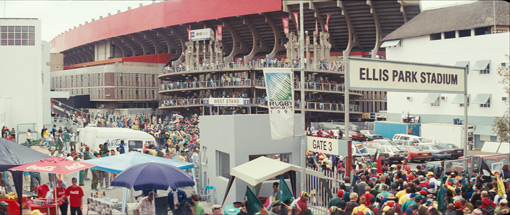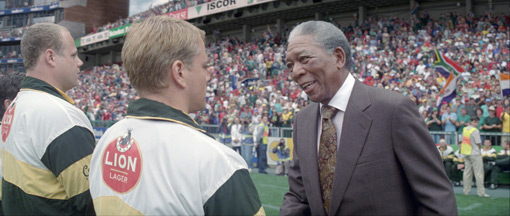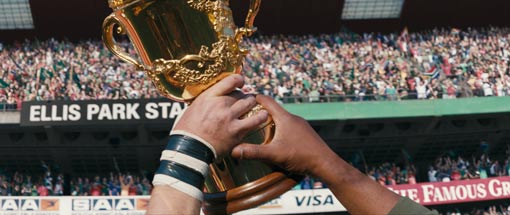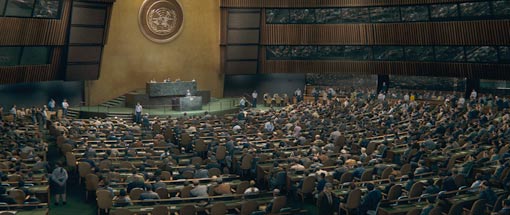VFX Supe Michael Owens on CG Rugby Stadiums, Digital Make-Up, and Tons of Roto

Mouseover film still above to compare to original live-action plate
“So far I’ve heard it plays like a movie with no effects,” he says. “It should be that way dramatically. It’s always fun to do a platform VFX show, but I really do enjoy straight drama and being able to enhance that with VFX.” Owens has been visual effects supervisor on a couple dozen films since the 1987 The Witches of Eastwick, including three other Clint Eastwood films: Changeling, Flags of Our Fathers, Letters from Iwo Jima, and Gran Torino.
To tackle the VFX for Invictus, Owens recreated the same team he used on Changeling: CIS Vancouver, with Geoffrey Hancock as the facility’s VFX supervisor. The task ahead of them was daunting. The film features six major rugby matches, and Owens and Hancock were tasked with creating stadiums teaming with enthusiastic fans. “In my mind, it was clear that it was going to be a virtual world,” says Owens. “We would have needed 60,000 extras for six weeks, and it was an economic as well as practical question. The first day, you call for 4,000 extras and 3,000 show up, and by the third day, 500 show up. Unless you had U2 playing, it would never have happened.”
In principle, all of the games could have been shot in the same venue. But for logistical reasons, they ended up shooting at one stadium in Johannesburg and another in Capetown. But the different look of each stadium didn’t matter. “Aside from the pitch [the grass playing field], everything else was replaced,” Owens reports. Why replace the stadium as well as add digital extras? “It’s much harder to match 3D CG people into a real world,” he says. “Subtle distortions would throw their positions off.”

Mouseover film still above to compare to original live-action plate
At CIS Vancouver, says Hancock, they’d already learned a lot about creating digital extras for Changeling that they were able to apply, to great effect, to Invictus. “With Changeling, we did virtual environments and a lot of digital pedestrians,” he says. “This was taking that technology, where we had very sculptable background people, and extending that to puppeteer the crowd to follow the emotional arcs in the game.”
Directing a Massive Crowd
With a reliance on Massive software, CIS Vancouver created a pipeline that would enable them to create crowds whose emotions they could then direct. They paired Massive with Houdini, with the idea that Houdini’s procedural nature would give them greater control later in the production cycle. The first step used Autodesk Maya for all the rigging and modeling, which was refined and textured with Pixologic ZBrush. The animation was all done through motion capture, and Hancock says they did extensive casting to create the demographics of the crowd. “Casting for this demographic allowed us to sync up certain body types, which looks the most natural it can be,” he says. “If you blend animation of one mocap actor onto a different body type, you end up with things that don’t hold up. Whether it was height, weight, hats, hair, color of team shirts, color of skin, we created the demographic palette we wanted.”

Mouseover film still above to compare to original live-action plate
CIS Vancouver created caches of 1,000 random people doing actions such as standing up and cheering, all of them in a slightly different way. “We’d feed that into Houdini and when we needed cheering people, there they were,” he says. The benefit of creating these caches was that the VFX artists never needed to go back to Massive when they wanted to make changes. “After we’d gone through the lay-out process, we could, say, swap a new body type on an individual or swap out his shirt,” says Hancock. “In that way, we could create vignettes that were interesting and pick out any illogical, unlikely or unfavorable combinations of a shirt and pants on one guy, or a beard on another. We had the ability to massage it without going back into the pipeline and re-simulating it with Massive. That allowed for much more iteration.”
In that way, they started to build up demographics that worked for each stadium scene. “Over the first shots of the game, we’d create the audience with the demographics we wanted, and from there on out, it would be dialing in the emotion of that shot,” says Hancock. This pipeline also helped them focus in on a specific digital extra and tweak him or her to get more realistic close-up shots.
CIS Hollywood also helped out with some of the crowd scenes. “They did some of the wider crowd shots, using a 2.5D sprite-based system leveraging our library,” says Hancock. “The images started in 3D, were mapped and then rendered in 3D. It was a render efficiency: we could render 30,000 cards faster than the full 3D people. In shots where we needed a lot of control, had special emotional moments or close-up shots, we used 3D because we had a great library to pull from.”

CIS Vancouver also created other virtual environments: matte paintings of Mandela traveling around the world and one spectacular shot of Mandela at the United Nations. “It was one of those virtual shots where they had Mandela on a podium, and the rest was created around him – including the delegates, all of whom were digital,” says Hancock.
Blood, Sweat and Tears (in CG)
A CG “blood and guts” team added approximately 200 shots to dirty up the rugby players. Rugby is a notoriously brutal sport, and rather than have to stop to add dripping blood, cuts, scrapes, bruises and grass stains, CIS Vancouver did the digital make-up. “Clint loved it and kept asking us to pour it on,” says Hancock. “And when you have 12 guys who are getting beat up, the continuity spirals up the count shot.” Owens reports that Eastwood did a bit of digital make-up in Flags of Our Fathers, to make the soldiers look more weathered, but really brought that into play for Gran Torino, when his character had to cry. “He wanted a single tear to come out of his eye, so we did that,” says Owens. “We could art-direct it: the timing, size, scope. It was a brilliant way to use VFX.”
Digital make-up also helped Eastwood in another way. “He’s always been frustrated with the time required for make-up effects,” says Owens. “He thought he could save a couple of days’ shooting and also art-direct it. The make-up artists were there on Invictus and they did what they could do. Then we ramped it up times 10 with digital effects.” The results, says Owens, are subtle but powerful. “I credit Clint completely with coming up with this,” he says. “He always embraces what will help, and this was the right thing to do.”
From Hancock’s point of view, creating digital make-up not only helped the speed of the shoot but was a boon to editorial. “Make-up ties you down to a certain order of shots,” he says. “In this case, they could re-order shots and play with things in editing and create continuity afterwards.” To track the rugby players as they move around the field, CIS Vancouver used Imagineer Systems’ Mocha, which, says Hancock, “does planar tracking really well and accurately. Whether it’s a cheekbone or a face turning or tilting, it lies in the 3D plane of the body and was accurate enough so we could have more detail closer-up. We could put the scrape or cut wherever we wanted to see it, and we didn’t have to avoid close-ups.” The blood-and-guts team – who were artists experienced in creating organic effects – then integrated the effects with Shake. CIS Vancouver partnered with CIS Hollywood on 150 out of a total of about 200 shots.

Mouseover film still above to compare to original live-action plate
When Good Colors Go Bad
The production did save a couple of days of shooting by using digital make-up, and that time came in handy when a serious problem cropped up. Invictus was shot with the same film stock – Kodak 5219 – as Gran Torino, with unanticipated results. “The problem of the ultraviolet and infrared hitting certain fabrics meant it absorbed certain colors and didn’t reflect back certain colors,” says Owens. The Springbok primary green jerseys went brown. “They were a completely different color,” says Owens. “If you were panning, it would start brown and turn green. The socks were turned to brown. And, by virtue of colors not being correct, the contrast would also change. It was a Pandora’s box.” Because it was a difficult problem to investigate, they went all the way through shooting before realizing the depth of the issue.
As a result, says Owens, Invictus was probably “one of the biggest rotoscoping jobs in the history of cinema.” Not only did the players have to be rotoscoped to put them in a virtual stadium, but now their jerseys, socks and, occasionally, visible skin had to be rotoscoped. Rotoscoping was done by facilities all over the globe, including Rotobotics (in Georgia/India); Prana (India); Anibrain (LA/India); and Xing Xing (Beijing), with camera tracking work by Vertigo (Macedonia) and Yannix (Bangkok).
Owens is already at work on Eastwood’s next film, Hereafter. Hancock, who calls Eastwood and Owens a good team, says he and CIS Vancouver look forward to working with them again. “The blood and guts was fun from the point of view of visceral storytelling,” he says. “But bringing the 3D people way closer to camera – one-third of screen height was the benchmark – coupled with the emotional response we were able to art direct was what I found to be very gratifying to accomplish.”
Did you enjoy this article? Sign up to receive the StudioDaily Fix eletter containing the latest stories, including news, videos, interviews, reviews and more.










Leave a Reply